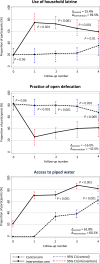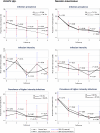WASH for WORMS: A Cluster-Randomized Controlled Trial of the Impact of a Community Integrated Water, Sanitation, and Hygiene and Deworming Intervention on Soil-Transmitted Helminth Infections
- PMID: 30628573
- PMCID: PMC6402916
- DOI: 10.4269/ajtmh.18-0705
WASH for WORMS: A Cluster-Randomized Controlled Trial of the Impact of a Community Integrated Water, Sanitation, and Hygiene and Deworming Intervention on Soil-Transmitted Helminth Infections
Abstract
Water, sanitation, and hygiene (WASH) interventions have been proposed as an important complement to deworming programs for sustainable control of soil-transmitted helminth (STH) infections. We aimed to determine whether a community-based WASH program had additional benefits in reducing STH infections compared with community deworming alone. We conducted the WASH for WORMS cluster-randomized controlled trial in 18 rural communities in Timor-Leste. Intervention communities received a WASH intervention that provided access to an improved water source, promoted improved household sanitation, and encouraged handwashing with soap. All eligible community members in intervention and control arms received albendazole every 6 months for 2 years. The primary outcomes were infection with each STH, measured using multiplex real-time quantitative polymerase chain reaction. We compared outcomes between study arms using generalized linear mixed models, accounting for clustering at community, household, and individual levels. At study completion, the integrated WASH and deworming intervention did not have an effect on infection with Ascaris spp. (relative risk [RR] 2.87, 95% confidence interval [CI]: 0.66-12.48, P = 0.159) or Necator americanus (RR 0.99, 95% CI: 0.52-1.89, P = 0.987), compared with deworming alone. At the last follow-up, open defecation was practiced by 66.1% (95% CI: 54.2-80.2) of respondents in the control arm versus 40.2% (95% CI: 25.3-52.6) of respondents in the intervention arm (P = 0.005). We found no evidence that the WASH intervention resulted in additional reductions in STH infections beyond that achieved with deworming alone over the 2-year trial period. The role of WASH on STH infections over a longer period of time and in the absence of deworming remains to be determined.
Figures



Similar articles
-
Risk factors for infection with soil-transmitted helminths during an integrated community level water, sanitation, and hygiene and deworming intervention in Timor-Leste.Int J Parasitol. 2019 Apr;49(5):389-396. doi: 10.1016/j.ijpara.2018.12.006. Epub 2019 Feb 22. Int J Parasitol. 2019. PMID: 30802450
-
(S)WASH-D for Worms: A pilot study investigating the differential impact of school- versus community-based integrated control programs for soil-transmitted helminths.PLoS Negl Trop Dis. 2018 May 3;12(5):e0006389. doi: 10.1371/journal.pntd.0006389. eCollection 2018 May. PLoS Negl Trop Dis. 2018. PMID: 29723193 Free PMC article. Clinical Trial.
-
Giardia duodenalis infection in the context of a community-based deworming and water, sanitation and hygiene trial in Timor-Leste.Parasit Vectors. 2019 Oct 18;12(1):491. doi: 10.1186/s13071-019-3752-9. Parasit Vectors. 2019. PMID: 31627736 Free PMC article. Clinical Trial.
-
The role of water, sanitation and hygiene interventions in reducing soil-transmitted helminths: interpreting the evidence and identifying next steps.Parasit Vectors. 2019 May 28;12(1):273. doi: 10.1186/s13071-019-3532-6. Parasit Vectors. 2019. PMID: 31138266 Free PMC article. Review.
-
Intervention strategies to reduce the burden of soil-transmitted helminths in India.Indian J Med Res. 2018 Jun;147(6):533-544. doi: 10.4103/ijmr.IJMR_881_18. Indian J Med Res. 2018. PMID: 30168484 Free PMC article. Review.
Cited by
-
Design of a parallel cluster-randomized trial assessing the impact of a demand-side sanitation and hygiene intervention on sustained behavior change and mental well-being in rural and peri-urban Amhara, Ethiopia: Andilaye study protocol.BMC Public Health. 2019 Jun 21;19(1):801. doi: 10.1186/s12889-019-7040-6. BMC Public Health. 2019. PMID: 31226957 Free PMC article. Clinical Trial.
-
Epidemiology of soil transmitted helminths and risk analysis of hookworm infections in the community: Results from the DeWorm3 Trial in southern India.PLoS Negl Trop Dis. 2021 Apr 30;15(4):e0009338. doi: 10.1371/journal.pntd.0009338. eCollection 2021 Apr. PLoS Negl Trop Dis. 2021. PMID: 33930024 Free PMC article. Clinical Trial.
-
Interventions to improve water, sanitation, and hygiene for preventing soil-transmitted helminth infection.Cochrane Database Syst Rev. 2022 Jun 21;6(6):CD012199. doi: 10.1002/14651858.CD012199.pub2. Cochrane Database Syst Rev. 2022. PMID: 35726112 Free PMC article.
-
Impact of the "BALatrine" Intervention on Soil-Transmitted Helminth Infections in Central Java, Indonesia: A Pilot Study.Trop Med Infect Dis. 2019 Dec 6;4(4):141. doi: 10.3390/tropicalmed4040141. Trop Med Infect Dis. 2019. PMID: 31817651 Free PMC article.
-
Effects of water, sanitation, handwashing and nutritional interventions on soil-transmitted helminth infections in young children: A cluster-randomized controlled trial in rural Bangladesh.PLoS Negl Trop Dis. 2019 May 3;13(5):e0007323. doi: 10.1371/journal.pntd.0007323. eCollection 2019 May. PLoS Negl Trop Dis. 2019. PMID: 31050672 Free PMC article. Clinical Trial.
References
-
- Bethony J, Brooker S, Albonico M, Geiger SM, Loukas A, Diemert D, Hotez PJ, 2006. Soil-transmitted helminth infections: ascariasis, trichuriasis, and hookworm. Lancet 367: 1521–1532. - PubMed
Publication types
MeSH terms
Substances
LinkOut - more resources
Full Text Sources
Miscellaneous

